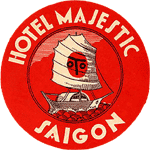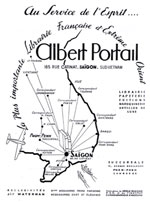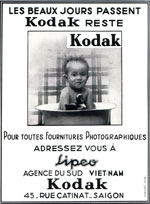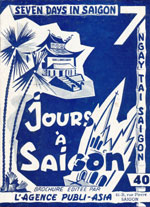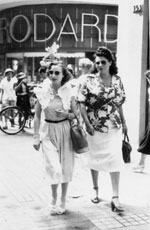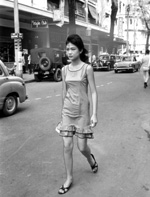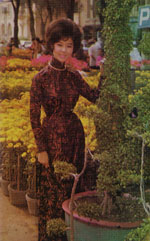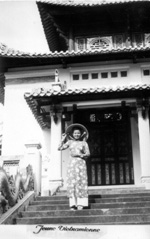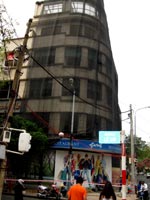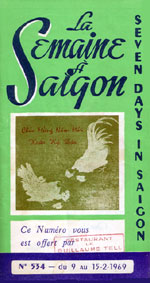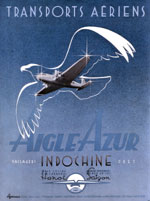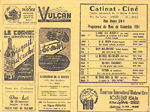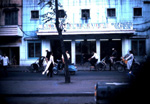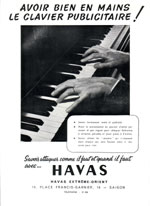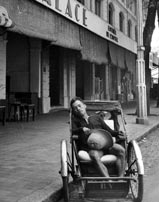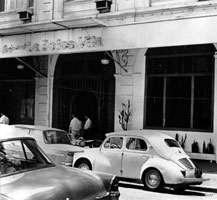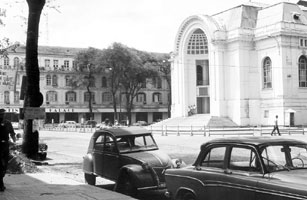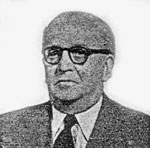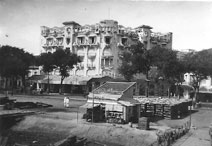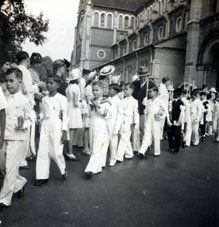
The business establishments and institutions on
Catinat Street
(now Đồng Khởi)
It got its name from the Admiral-Governor de la GrandiÃĻrele on February 1st, 1865, in honor of the corvette 'Catinat' (Nicholas Catinat was MarÃĐchal of France from 1637 to 1712), which had taken part in the actions of 1856 at Tourane (Da Nang), and 1859 in Saigon.

The Hotel Continental
"The Hotel Continental was built in 1880 by Pierre Cazeau, a contractor for a construction materials company. The Duke of Montpensier bought the hotel in the beginning of the 20th century for his girlfriend and later sold it to Mr. Frazetti who remained its owner until 1930.
During the â20âs, Catinat St. where the Hotel Continental was located became the âCanebiÃĻreâ (historic high street in the old quarter of Marseilles) of Saigon. The famous writer AndrÃĐ Malraux and his wife Clara stayed there from 1924 to 1925.
" In 1930, Mathieu Franchini, a figure in the Corsican epic in Indochina, bought the hotel and successfully ran it for 30 years. During the Second World War many weekly magazine offices set up shop in the Continental: "Time" on the first floor, "Newsweek" on the second. After the defeat at Dien Bien Phu, Mathieu Franchini returned to Europe.
From 1964 to 1975 Mathieu Franchiniâs son Philippe ran the hotel until the fall of the South Vietnamese government. In 1977 Philippe Franchini published an excellent book through the publishing house of Olivier Orban about the âSaigon Continentalâ, from which comes the following extract relating a situation that took place in the beginning of the 1950âs:
"At the Continental, at the table of the Senators which that of Oscar Berquet had followed in the first years of the century, and those of the twenty-two, were now seated the Corsicans, the old friends of my father, old colonials like himself. Whether they stayed inside the hotel at the edge of the garden or on the sidewalk, at the tip of the angle formed by Catinat St. and Theater square, they got together every day at apÃĐritif-time and in the rediscovered aroma of pastis. Civil servants or peaceful magistrates, they always conversed in patois. It was their way of recapturing the spirit of the homeland, to feel the wind of the back country penetrating their lungs. Since they had been living in Indochina some of them had picked up the habit of opium. This explained the punctuality with which they arose to return home at the demanding time of the magic pipe. These
reunions, to which the old colony had become accustomed, were nothing more than peaceful and normal, but to which new arrivals and transient foreigners attributed secret or less-than-honorable intentions. The Corsicans and their dialect both intrigued and irritated."
The reasons for which reporters chose the Hotel Continental were quite simple, since it was located in the heart of Saigon across from the National Assembly (today the Municipal Theater) where the international press would get together to collect information on the various wars on the Indochina peninsula.
At the end of the â40âs and beginning of the â50âs its terrace, nicknamed âRadio Catinatâ, had again become the meeting-place for all-Saigon, the center of all intrigue and all the townâs gossip.
Its famous restaurant âLe Perroquetâ was never empty !!
Patrons considered themselves at home at the Continental as AndrÃĐ Malraux had done in the â30âs, and in the beginning of the â50âs the British author Graham Greene (a regular in room 214), author of the book âThe Quiet Americanâ, which was twice adapted for the screen in 1958 and 2002. It was a book that told of the last days of the French in Indochina, and the beginning of the American presence in the future Vietnam.
(Graham Greene was under suspicion because he belonged to the Secret Services of the United Kingdom, and was placed under surveillance by an agent of the Viet-Minh intelligence services)
Lucien Bodard was a famous reporter for âFrance-Soirâ from 1948 to 1975, nicknamed âLulu le Chinoisâ (âChinese Luluâ) by his colleagues because of his birth in Chongging, Sichuan province, China in 1914.He was a war correspondent in Indochina from 1948 to 1955, and naturally, stayed at the Hotel Continental.
Of course we canât forget Jean LartÃĐguy either, who wrote âFarewell to Saigonâ in 1975. It was written day-to-day in a room of the Hotel Continental in Saigon. Jean LartÃĐguy describes the final hours of a city he loved which bore the pretty name âSaigonâ, and the birth of another, âHo Chi Minh Cityâ, which he doesnât much care for.
Itâs also the farewell of the soldier, of the journalist, of the writer, to the country where he had known extraordinary adventures, the memory of which comes back during the long nights of the curfew.
La Dolce Vita Restaurant
April 1967 : Simon and Anna Faby operate the "La Dolce Vita" restaurant attached to the old Continental Palace Hotel. The top center picture shows an interior view of the restaurant. Across the street is the Caravelle, probably Saigon's best-know hotel.
Uncertain Future
Sept 13, 1973 : Philippe Franchini, proprietor of the Continental Palace, waits outside his etablishment in Saigon. The rooms and restaurants of the Continental, once host to the elite and wealthy, are almost empty now.
Reopened in 1989 after being nationalized
The hotel closed in 1975 a few weeks after the fall of Saigon and reopened in 1989 after being nationalized. Today the Hotel Continental remains one of the greatest symbols of the French presence in Cochin China.
A magnificent bronze statue of Napoleon in the lobby remains as a testament to its Corsican owners.
Photo Gallery on Catinat Street

The Opera or Municipal Theater
Nhà hÃĄt lớn Thà nh phố Sai GÃēn
Francis Garnier Square
The Municipal Theater was built in 1910 by the architecture firm of FÃĐlix Ollivier, Ernest Guichard, and EugÃĻne Ferret. Hosting theater companies from Paris or divas just passing through, it enlivened somewhat the
city in which the elite got bored in the evening. It was inaugurated in the presence of Prince Waldemar of Denmark.
In the architectural style of the Third French Republic, the façade is inspired by the Petit-Palais in Paris. The interior appointments are well-equipped with perfect acoustics and lighting. The building includes a general-seating area and two balconies, for a total of 1800 seats. DÃĐcor, inscriptions, and
furniture were designed in France by famous French artists and sent to Saigon. In 1943 a part of this dÃĐcor was removed during the Japanese occupation.
The theater is located on Francis Garnier Square, across from the Hotel Continental.

The Book and Stationery store of Albert Portail
Mr. Albert Portail, founder of the company which bears his name, arrived in Saigon on April 13th, 1905, having been hired by the MÃĐnard-Rey printing company, of which he became the manager in 1908.
In 1910, he acquired the New Coudurier & Montegout Printing Company, formerly the Claude Company, established in 1881. This printing company also featured a small book shop located at 109 Catinat Street, on the future site of the Pharmacie de France. In Phnom Penh it took up five storefronts on the docks. It was from these fragile beginnings that Mr. Portail would build the largest French book- and stationery establishment in the Far-East.
The store moved for the first time, to No. 177 Catinat Street, then in 1920, to No. 185 of the same street. Mr. Portail also built, starting in 1914, a large printing facility on the corner of Cornulier-LuciniÃĻre and Rudyard Kipling Streets. Finally in 1930, the expansion of his business in Phnom Penh led Mr. Portail to acquire a building located at No. 14 Avenue Boulloche, where he set up a modern printing shop as well as a book- and stationery store.
After the war, on January 1st, 1948, the Portail Printing Company of Saigon was sold to the Imprimerie Française d'Outre-Mer (The French Overseas Printing Company), Mr. Portail having decided to devote all his activities in South Vietnam to the book- and stationery business which was growing ever larger and which in 1949 led him to expand his stores which at the time took up five storefronts, from No. 185 to No. 193 Catinat Street.
Mr. Albert Portail, who had left Saigon for good in 1953 and had entrusted the management of his businesses in Indochina to his two sons, RenÃĐ and Ernest, had also created a Purchasing Bureau in Paris which was now located at No. 10, ChaussÃĐe d'Antin. From of the end of the Second World War, this Purchasing Bureau was run by his son RenÃĐ and his businesses in Indochina by his eldest son Ernest, who was assisted, until May 15th, 1953, by its Director, Mr. Henri Duqueyroix. Mr. Duqueyroix retired in 1954 and was replaced in his duties by Mr. RenÃĐ Marquet.
Propelled by this spirit of enterprise which remains an attribute of men of his generation, Albert Portail gave Indochina its largest distribution center for books, newspapers, magazines and periodicals from every nation and source.
The International Cultural Organisation of UNESCO and the UN also entrusted the sale of their publications to the A. Portail Bookstore.
Its creator could not have received a better tribute.
During the Second World War, despite his years, Mr. Albert Portail's conduct was a fine example of civic courage, worthy of his working past, as he was interned for many long months in the prisons of ChambÃĐry, Saint-Paul d'Eyjeaux, CompiÃĻgne, and Fresnes.
It was therefore with some pride that he was able to regain what was always his motto:
Ad Augusta per Augusta
In his loose translation:
"The road to success bristles with difficulties".

La Croix du Sud
The Southern Cross
(after Tu Do Cabaret)
Near the harbor at the 80-82 Catinat Street next to the Hotel Majestic is the neighborhood of the Corsican Quarter with its numerous cafÃĐs and night clubs. The best-known among them is âLa Croix du Sudâ, âThe Southern Crossâ, whose owner is a Corsican by the name of Monsieur AndrÃĐani. The women of the AndrÃĐani family keep a close watch over the cash register.
This establishment is frequented by military customers as well as other workers who come to listen to music played by an all-female orchestra of about a dozn members in dressed garnished in âfrogs and loopsâand plumes, all under dull florescent lights..
At â La Croix du Sud â, strict discipline reigns. The audience is allowed only to drink and to look at the legs of the ladies of the orchestra! In the cafÃĐâs back room which is his HQ, Mr. AndrÃĐani assembles his Corsican friends to discuss âreal businessâ.
Mr. AndrÃĐani is a genuine celebrity in Saigon. A shepherd in his native Corsica, he arrived in Indochina as a seaman before the Second World War and was first a pimp, and then ran a brothel.
After that Mr. AndrÃĐani would be involved in the traffic of piasters, and would maintain excellent relations with the deciders of the time, the Chinese billionaires of the âGrand Mondeâ (a gaming establishment), well-off Vietnamese women and even high-level French bureaucrats.

La Pagode
The Bar "La Pagode" is located at 209 Catinat Street at the corner 47-57 LÊ-Loi Street.
French pastries specialities, tea room, bar.
It was the rendezvous for French military personnel.

The Denis Brothers of Indochina
![]()
![]()
![]()
A corporation with a capital of 28 million Indo-Chinese Piastres.
Import-Export; Armaments; Insurance; Agents for: Lloyds of London, The Committees of Maritime Insurers of Paris, Le Havre, and Nantes.
Representatives in France: "Denis FrÃĻres" in Bordeaux.
Companies represented:
Mont-Blanc milk, Bisquit Dubouche Cognac, Veuve Clicquot Champagne, Cap Corse Mattei, Quinquina Saint-RaphaÃŦl, Rhum Duquesnes, Barton & Guestier Bordeaux wine, Dopff Alsatian wine, BlÃĐdine Jacquemaire.
Agency Companies :
Air France, Air Vietnam, Union AÃĐro Maritime de Transport, Transport AÃĐriens Intercontinentaux, Pan American Airways, Cathay Pacific Airways, Macau Air Transport, Air Ceylon.
Denis frÃĻres
4, Catinat Street
Saigon

The Hotel Majestic
Built in 1925, the hotel is located right at the end of Catinat St. (now Dong Khoi St.), at the corner of the Le Myre de Villiers embankment (now Ton Duc Thang St.).
It consists of four levels and 44 rooms in the colonial style. During the Second World War the Japanese Imperial army used this building as a barracks. During the Vietnam War the Majestic was used by war correspondents from all over the world.
In 1948 it was purchased by the Tourism and Exposition of Indochina Company; in 1951 it was granted as a concession to a certain Mathieu Franchini by the Office of Tourism and the Ministry of Finance.
At the expiration of this concession in 1965, the Office of Tourism refused to renew Mr. Franchiniâs contract, as he was in a delicate position due to the severance of diplomatic relations between France and Vietnam on June 24, 1965.
In 1968 the hotel gained two floors, an international conference center, a restaurant, and a few additional rooms.

The business establishments and institutions on
Tu Do Street
(now Đồng Khởi)
The famous Catinat Street would become Tu Do (Liberty) Street from 1955 to 1975 during the war between South- and North-Vietnam.
After the fall of the South-Vietnamese government it would be renamed Đồng Khởi (General Insurrection).
Saigon Palace hotel
8 Tu Do Street
Saigon Palace Hotel (or Grand Hotel) was during a long time the third most important hotel on Tu Do Street (formerly Catinat).

South Vietnamese Parliament
Lam Son (formely Theater) Square
The Municipal Theater was built in 1910 by the architecture firm of FÃĐlix Ollivier, Ernest Guichard, and EugÃĻne Ferret. Hosting theater companies from Paris or divas just passing through, it enlivened somewhat the
city in which the elite got bored in the evening.
Last in the 50âs and the beginning of the 60âs this theater was the seat of the South Vietnamese parliament.
For the 300th anniversary of the founding of Saigon the city government had a part of the façadeâs dÃĐcor reconstructed.

Caravelle Hotel
23, Lam Son Square
The Hotel Caravelle opened in 1959, at the time, it was located on Francis Garnier Square (Theater).
It housed numerous foreign embassies during the 1960's, as well as the bureaus of the "New York Times" and the "Washington Post". In August 1964 it was the target of a bombing, and in 1975 the hotel was nationalized by the new regime.
It returned to its original name in 1998 following a complete renovation on the square presently known as Lam Son.
In the 60's:
"Air-France" Agency is located at Caravelle Hotel ground floor at the corner of Tu Do Street (formeley Catinat) and Law Son Square (formely Francis Garnier or Theater).

The Cathedral of Notre Dame
John F. Kennedy Square
(formely Pigneau de Behaine Square)
To day CÃīng xÃĢ Paris (Paris Commune Square)
In August of 1876 the governor of Cochin China, Mr. DuprÃĐ, organized a contest to determine the architectural style of Notre Dame Cathedral. The purpose of this was twofold: to give the colonial missions a place to worship, but also to show the Vietnamese, through architecture, the
strength of French civilization.
The project, by architect Jules Bourad, was based upon the Cathedral of Notre Dame of Paris, but smaller in size with a Romanesque revival and Gothic style.
All construction materials were imported from France. In particular, the outside of the structure was fashioned of bricks made in Marseilles, and without a coating, has retained its original bright pink color. With its 93 m. (305 ft.) length, 35.5 m. (116.5 ft.) width, and 57.6 m. (189 ft.) height from the ground to the tip of the steeple.
In 1895 two bell towers were added to the cathedral, each 57.6 m. (189 ft.) high featuring 6 bronze bells for a total weight of 28 (metric) tons, made in France.
Crosses were added to the top of each tower; they are 3.5 m (11.5 ft.) high, 2 m. (6.5 ft.) wide, and weigh 1000 Kg.(2200 Lbs.). At the end of the 19th century the building symbolized the most beautiful workmanship of French Indochina, more specifically of the Indochina Union.
Holy Communion in the Cathedral in 1938
Holy Communion on Sunday, May 28th, 1938 in the Notre-Dame of Saigon cathedral.
The Cathedral, seen from Catinat Street
On 7 and December 8, 1959, with the approval of the Vatican, the cathedral was consecrated Saigon Basilica.

More souvenirs on Catinat and Tu Do Street in the years 50's et 60's
|
La rue Catinat Alimentation GÃĐnÃĐrale "Thai-Thach", Imprimeries et Librairies Indochinoises, l'opticien Michaux, la PÃĒtisserie Brodart, aux NouveautÃĐs Catinat, Givral, CinÃĐma Eden. ici |
Catinat Street "Thai-Thach" grocery store, SociÃĐtÃĐ des Imprimeries et Librairies Indochinoises, optician Michaux, Brodart, Catinat novelties "Lucien Berthet", Givral, Eden theater. here |
|
La rue Tu Do Restaurant-ThÃĐÃĒtre Maxim's, le cabaret Tu Do, les Chaussures Bata, La Maison Brodart "Le Bougnat", le cafÃĐ Givral... ici |
Tu Do Street Maxim's Restaurant-Theater, Bata Shoes, the Maison Brodart "Le Bougnat", the Givral Bar, the Southern Cross... here |


